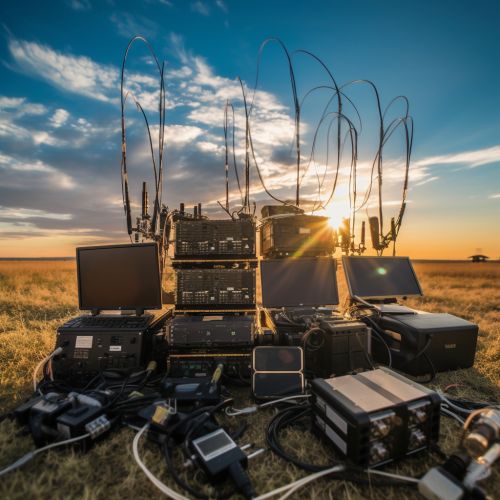Electronic Warfare
Introduction
Electronic warfare (EW) is a strategic and tactical practice that involves the use of the electromagnetic spectrum or directed energy to control the spectrum, attack an enemy, or impede enemy assaults. The purpose of electronic warfare is to deny the opponent the advantage of, and ensure friendly unimpeded access to, the electromagnetic spectrum. EW can be applied from air, sea, land, and space by manned and unmanned systems, and can target humans, communications, radar, or other assets Military strategy.


History
Electronic warfare has a long history that dates back to the early days of radio communication. The first recorded instance of EW was during the Russo-Japanese War of 1904-1905, where the Russians used a spark-gap transmitter to jam the radio of a Japanese naval vessel. Since then, EW has evolved and grown in complexity, with each new conflict bringing new advancements and techniques History of EW.
Types of Electronic Warfare
There are three main types of electronic warfare: electronic attack (EA), electronic protection (EP), and electronic warfare support (ES).
Electronic Attack
Electronic Attack (EA) involves the use of electromagnetic energy, directed energy, or anti-radiation weapons to attack personnel, facilities, or equipment with the intent of degrading, neutralizing, or destroying enemy combat capability. EA is divided into three categories: jamming, deception, and directed energy Electronic Attack.


Electronic Protection
Electronic Protection (EP) involves actions taken to protect personnel, facilities, and equipment from any effects of friendly or enemy use of the electromagnetic spectrum that degrade, neutralize, or destroy friendly combat capability. EP includes actions such as frequency hopping, power management, and the use of protective coatings and materials Electronic Protection.
Electronic Warfare Support
Electronic Warfare Support (ES) is a subdivision of EW involving actions tasked with the interception and identification of electromagnetic emissions, the location of their source, and the analysis and distribution of this information to aid in decision making. ES data can be used to produce signals intelligence (SIGINT), provide direction finding (DF) capabilities, and assist in the development of electronic attack (EA) and electronic protection (EP) measures Electronic Warfare Support.


Electronic Warfare in Modern Warfare
In modern warfare, electronic warfare plays a crucial role in the overall success of military operations. It is used to disrupt enemy communications, prevent enemy air defenses from tracking and engaging aircraft, and to protect friendly forces from similar enemy capabilities. The increasing reliance on digital systems in modern militaries has made electronic warfare an essential aspect of military strategy Modern Warfare.


Future of Electronic Warfare
The future of electronic warfare lies in the development of new technologies and techniques to counter emerging threats. This includes the use of artificial intelligence (AI) to automate and enhance EW operations, the development of new materials and technologies for improved electronic protection, and the exploration of new methods for electronic attack. As technology continues to advance, so too will the capabilities and complexity of electronic warfare Future of EW.


